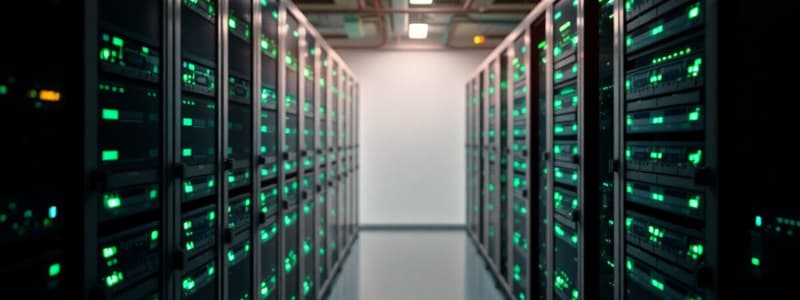Podcast
Questions and Answers
Which method improves reliability by linking several servers together?
Which method improves reliability by linking several servers together?
- Bus topology
- Ring topology
- Clustering (correct)
- Star topology
What is the purpose of installing an uninterruptible power supply (UPS) in a network setup?
What is the purpose of installing an uninterruptible power supply (UPS) in a network setup?
- To enable disk mirroring
- To increase network speed
- To prevent hardware crashes due to power issues (correct)
- To improve disk performance
What networking software is essential for a PC to function properly on a network?
What networking software is essential for a PC to function properly on a network?
- Device driver
- Network Operating System (NOS) (correct)
- Firmware
- System software
What technique is used to enhance performance and reduce the risk of server failure?
What technique is used to enhance performance and reduce the risk of server failure?
Which type of physical connection is commonly used in office Local Area Networks (LANs)?
Which type of physical connection is commonly used in office Local Area Networks (LANs)?
How can applications request data from a disk drive within a network?
How can applications request data from a disk drive within a network?
Which network topology requires that each node is connected to a central hub or switch?
Which network topology requires that each node is connected to a central hub or switch?
What element differentiates end-user computers from servers in a network?
What element differentiates end-user computers from servers in a network?
Which of the following best describes a bus topology?
Which of the following best describes a bus topology?
What is a primary characteristic of a ring topology?
What is a primary characteristic of a ring topology?
Which network configuration would likely be the least expensive to set up?
Which network configuration would likely be the least expensive to set up?
In a star topology, what is the role of the central hub?
In a star topology, what is the role of the central hub?
What is a significant disadvantage of using a ring topology?
What is a significant disadvantage of using a ring topology?
What is the main distinguishing feature of a mesh topology?
What is the main distinguishing feature of a mesh topology?
Which troubleshooting issue is most common for a bus topology?
Which troubleshooting issue is most common for a bus topology?
Which topology tends to be the most robust against failures?
Which topology tends to be the most robust against failures?
What occurs when a malfunction happens in a linear bus topology?
What occurs when a malfunction happens in a linear bus topology?
Which aspect of star topology allows for easier troubleshooting compared to linear bus topology?
Which aspect of star topology allows for easier troubleshooting compared to linear bus topology?
What complicates the maintenance of a ring topology, particularly in larger networks?
What complicates the maintenance of a ring topology, particularly in larger networks?
Which factor contributes to the expense of mesh topology networks?
Which factor contributes to the expense of mesh topology networks?
What is a significant disadvantage of star topology related to hardware?
What is a significant disadvantage of star topology related to hardware?
What is the primary benefit of fault tolerance in mesh topology?
What is the primary benefit of fault tolerance in mesh topology?
How do data transmissions work in star topology when multiple stations attempt to transmit simultaneously?
How do data transmissions work in star topology when multiple stations attempt to transmit simultaneously?
Which is a common misconception about network configuration in star topology?
Which is a common misconception about network configuration in star topology?
Flashcards are hidden until you start studying
Study Notes
Hard Disk Capacity
- The hard disk capacity should be large enough to avoid the need for upgrades in the near future.
Network Resilience
- To mitigate hardware failures, install an uninterruptible power supply (UPS) or run two disks in parallel using disk mirroring or Redundant Array of Inexpensive Disks (RAID) techniques.
Network Clustering
- Clustering involves linking servers together via high-speed connections (e.g., fiber-optic cabling) to distribute workload and enhance reliability and performance.
- This approach enables parallel processing, where tasks are shared between processors, and storage mirroring to improve performance and minimize the risk of server failure.
Client Computers
- Client computers are access points for users and are commonly referred to as clients, nodes, workstations, or PCs.
- Utilize the term "client PC" to distinguish client devices from server PCs.
- Each client requires networking software like Open Enterprise Server (OES) or TCP/IP for network operations.
- Client PCs on a LAN connect to the network via a network interface card (NIC) installed in a slot.
- Home PCs connected to the internet utilize a modem instead of a NIC.
Network Operating Systems
- Applications interact with disk drives on the network through a Network Operating System (NOS).
- The NOS functions as system software that controls network systems and devices, enabling communication.
- Similar to a computer's operating system, the NOS manages memory, tasks, and coordinates hardware.
Network Topologies
- Network topologies describe the physical layout of computer connections and the devices used.
- The four primary topologies are bus, ring, star, and mesh.
Bus Topology
- In a bus topology, computers are connected to a shared communication cable (the bus).
- Data travels bidirectionally along the bus.
- A malfunction on one station can disrupt the entire network.
- Maintaining a logical ring in larger networks is challenging.
- Network adjustments or reconfigurations require temporarily shutting down the entire network.
Ring Topology
- In a ring topology, computers are connected in a circular fashion.
- Data packets flow in one direction.
- A malfunction on one station can disrupt the entire network.
- Maintaining a logical ring in larger networks is challenging.
- Network adjustments or reconfigurations require temporarily shutting down the entire network.
Star Topology
- A star topology connects all computers to a central hub.
- Data transmission flows directly to the hub and is then forwarded to the destination.
- Computers can attempt to send data at any time, but only one transmission can occur simultaneously.
- If two stations transmit data at the same time, neither transmission is successful, requiring the computers to retry after a random delay.
Advantages of Star Topology
- Malfunctions on one station do not disable the entire network.
- It is easier to locate cable breaks and other malfunctions.
- The centralized hub simplifies adding new computers or reconfiguring the network.
Disadvantages of Star Topology
- Requires more cabling than other topologies due to separate lines for each computer.
- The central hub is a single point of failure, and its malfunction shuts down the entire network.
Mesh Topology
- In a mesh topology, each computer is connected to every other computer on the network.
- Requires significant amounts of cabling, increasing cost and installation complexity.
- The main advantage is fault tolerance.
- A network with a broken segment allows data to travel through alternate paths.
Network Types
- Networks are classified based on geographic scope.
Local Area Network (LAN)
- LANs cover a small area like a classroom, school, or single building.
- Costs are lower compared to other network types.
- LANs are typically used for local communications and have high speed components.
Metropolitan Area Network (MAN)
- MANs span a city-wide distance.
- While speeds are typically comparable to LANs, they require high-speed connections like fiber optics.
- The extended distance and advanced technology increase installation and operations costs.
Wide Area Network (WAN)
- WANs networks cover a larger area extending beyond a metropolitan city.
- They utilize long-distance telecommunications for connections, increasing costs.
- The Internet is a large example of a WAN.
Studying That Suits You
Use AI to generate personalized quizzes and flashcards to suit your learning preferences.




